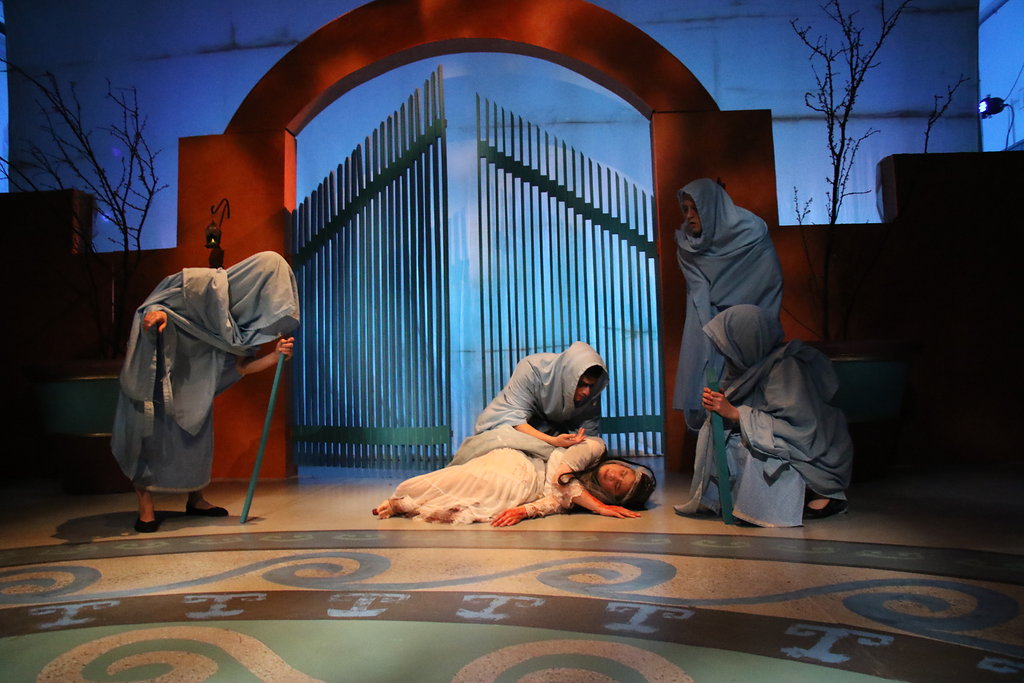What’s the weirdest thing you ever believed in? A ghost? A spiritual practice? A religion? What about an urban legend? We’ve all heard them. We all have them. Some of us have even experienced them. What happens when one story crosses through multiple cultures, where everyone knows a different version of the story? Cohesion Theatre Company, in their first attempt at running shows in rep, presents La Llorona, written by Cecelia Raker, a legend or scarytale that transcends multiple cultures and impacts the lives of three young girls in striking and inspiring manners. Directed by Susan Stroupe, this evocative and harrowing coming-of-age tale deeply explores the cultural narrative of adolescent girls from three unique cultural backgrounds and addresses difficult topics with darkened levity and compassionate emotional understanding.
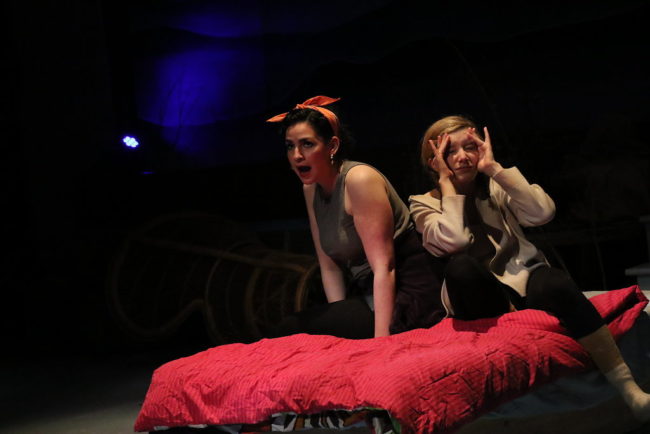
Playwright Cecelia Raker makes her playwright’s debut with this full-length piece. Despite the impressive topics covered, the deeply moving emotional arc of the three main characters, and the fascinating exploration of cultural connections and difference, Raker’s work is a bit long for the modern audience. There is a more succinct and efficient way to adeptly express exactly what she’s after, and taking out some of the repetition Raker uses, as well as slightly editing some of the lengthier monologue-driven scenes would readily put this play on track to be a game-changing head stopper. That said, Raker’s voice is unique in the fact that she captures three different cultural voices— a Native New Mexican teenager, a New England Jewish Teenager transplanted to New Mexico, and a Native American teenager dealing with the duality of her nationality. All three characters are women, and although they have striking similarities in the way they are presented and the way they are explored, Raker’s focus is on drawing the dividing line between this individual cultures, showcasing not only their differences but their similarity through their differences.
Raker’s ability construct believable dialogue is her strongest suit; the monologue-driven scenes where each of the three main teenagers are addressing their issues aloud are striking. They carry weight and at times appropriately balanced, albeit darkened, levity. There are lines that stick with you— “…you take the pill and the Pope will forgive you but your grandma never will…”— in reference to difficult topics like teenage pregnancy. It’s a well-constructed piece, even if it does err on the lengthier side of running. The way Raker handles these issues— cultural disparity, female adolescence, etc.— juxtaposed against her hybrid of mythical-magical realism is an intriguing new approach to coming of age tales. Suspending disbelief of the supernatural so that these budding individuals’ experiences are shaped by their encounters with the spirit/ghost/entity of La Llorona is a refreshing and exhilarating way to approach these subject matters.
Director Susan Stroupe has masterful command of the piece; she strives to give these unique cultures and individuals voices by casting racial and culturally appropriate individuals as well as allowing the story to stand on its own. Respectfully creating art that allows cultural diversity from a culture not her own is a directorial success for which Stroupe is known throughout Baltimore; La Llorona is just her latest success with this practice. Despite the play’s length, Stroupe keeps the scenes moving and does some exquisite things with the supernatural approach to the production.
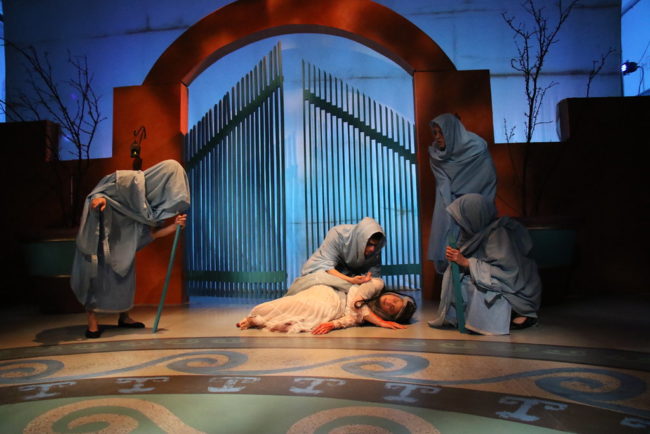
Scenic Designer Jess Rassp and Scenic Artist Allison Bloechl fully articulate Stroupe’s vision of La Llorona by creating a physical gate in the style of a New Mexican pueblo. The color scheme as well as the decorations are on point for the cultural elements of this production. The scenic aesthetic is augmented by Lighting Designer Helen Garcia-Alton, who uses blues and shades of shadow to create the ethereal otherworld every time we encounter Llorona at the gate. Sound Designer Meghan Stanton further enhances the experience with her use of other-worldly sound effects, creating moments of serenely disturbing tranquility in the show’s soundscape.
Stroupe has employed the use of a moving ensemble in this production, utilizing four actors as Gatekeepers. Chara Bauer, Christian Gonzalez, Jonathan Jacobs, and Mika J Nakano all lend their bodies and voices to these roles, occasionally serving as ancestors or ghostly apparitions in scene with the other, living characters. They move fluidly and gracefully, sweeping about in the heavenly blue robes (crafted smartly by Costume Designer Elizabeth Ung) to create a sense of celestial existence. Their voices at times are distorted, intentionally so, when responding to La Llorona at the gates, speaking in varied tongues to ask her over and over the question of her missing children. This chilling effect, as well as the extraordinary “Heavenly Gatekeeper” puppet (Properties Designer Alisa Glenn), are some of the most memorable moments in the show that happen outside of the trio of leading teen characters.
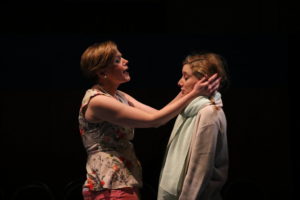
Most definitely not a teen, but still of the mortal, earth realm, Laura Malkus tackles the difficult role of the helicopter mom. Completely self-absorbed, Malkus hones in on the glaring character defects of ‘Mom’ and augments them to the point of simultaneous revulsion and hilarity. It’s amusing to see someone so absurd in action and revolting to realize that there are people who behave in this manner and believe that there is absolutely nothing wrong with their behavior. Malkus does a fine job of making us loathe this character, bristling against her as her daughter Rachel does. There is something innately unsettling about her ‘maternal approach’ to being in this relationship with her daughter Rachel. Malkus is a spitfire, and perfectly well-suited for the role.
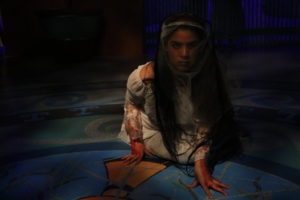
Mani Yangilmau mounts the difficult task of playing the undead. Despite the questionable mask attached to La Llorona’s head (as it looks really crude and juvenile, and the actress’ hair does an extraordinary job of masking her face when she’s skulking about, to the point where it feels unnecessary and out of place) Yangilmau traverses the treacherous terrain of the character’s ethos and pathos with a steady hand and a surefire balance. There are multiple components to La Llorona; she isn’t just a scary baddie come from the other side to torture the children. But she’s also not a simplistic victim of her circumstance. Much emotional nuance and fine-tuning has gone into Yangilmau’s portrayal of this entity, La Llorona, and the experience is an extraordinary one.
Natanya Washer, Mia Ybarra, and Emily Sucher share and shoulder the responsibility of the adolescent narrative in this production equally. These three outstanding performers provide gravitas and raw emotional expression with great consistency throughout the production, each one finding their own footing in the character’s cultural roots as well as the touchy situations of being a teenage woman. The onus of these cultural stories is well respected and delicately handled by Washer, Ybarra, and Sucher; each of these performers creates realistic moments of cultural identity for their characters, and these moments often surface around their personal interactions with La Llorona.
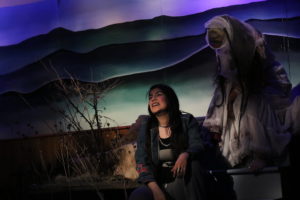
Mia Ybarra, as Molly the Native American, has a rough-hewn surface to her character. Neither spastic like the Rachel character or bombastic like the Maria character, Ybarra’s Molly is still, like a dried river bed, etched deep with history but no longer moving. Don’t underestimate her emotional depth portrayal, however, just because Ybarra internalizes the character’s energies and pathos does not mean she’s incapable of fully expressing them outright. Delivering one of the most evocative lines of the show, “Who’s supposed to teach me how to be a good Indian?”, there is a weighty depth to her character as she explores dealing with her cultural identity as well as body-image issues, a topic that plagues all women, teenagers, children, and adults alike.
Natanya Washer, as Maria the native to New Mexico, is gritty and prickly, not unlike the cacti for which the region is known. Harsh and using her attitude as a defense mechanism for the character, Washer portrays Maria to be the typical headstrong teenager who can’t show weakness out of fear. Her emphasis on the natural accent of the character gives a local flavoring to her performance in a respectful and reverent manner without caricaturizing it. During her solo scenes as well as her encounters with La Llorona, Washer is explosive and driven with emotional conviction.
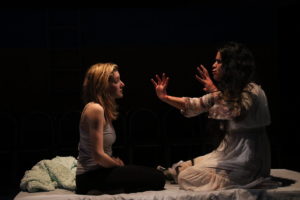
Emily Sucher, as the spastically high-strung Rachel, is at first the annoying character that you want to dislike because of how jittery her character is expressed. This quickly fades as you come to grips with the struggles that Rachel faces in a broken home, transplanted away from her surroundings and friends, struggling with her faith, sexuality, and overall identity as a human individual growing up as a teenager. Sucher’s approach to Rachel is convivial and quite refreshing, as this particular style of character could readily be played as a stereotype. She’s earnest and raw, actively present in every moment, especially when blasting her mother out of the water, and deeply questioning her own identity through her interactions with La Llorona.
La Llorona speaks to us all; we’ve all struggled with self-identity at one point in our lives, and we’ve all found ourselves growing up as teenagers not knowing how to cope with a multitude of situations. How different our stories might have been if we too had had an urban legend-style experience to pave a new path in our journey. La Llorona is the culturally diverse theatre that Baltimore is known for and it would be a pity to miss out on this rare opportunity.
Running Time: 2 hours and 40 minutes with one intermission
La Llorona plays in repertory with The Orphan Sea through April 15, 2018 at Cohesion Theatre Company in the Fallout Shelter of the United Evangelical Church— 3200 Dillon Street in the Canton neighborhood of Baltimore, MD. Tickets are available at the door or in advance online.

